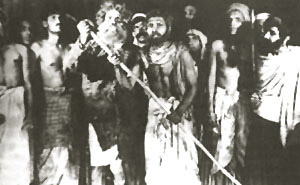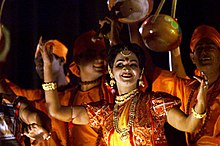
Bengal is a geopolitical, cultural and historical region in South Asia, specifically in the eastern part of the Indian subcontinent at the apex of the Bay of Bengal, predominantly covering present-day Bangladesh and the Indian state of West Bengal. Geographically, it consists of the Ganges-Brahmaputra delta system, the largest river delta in the world and a section of the Himalayas up to Nepal and Bhutan. Dense woodlands, including hilly rainforests, cover Bengal's northern and eastern areas, while an elevated forested plateau covers its central area; the highest point 3,636 metres (11,929 ft) is at Sandakphu. In the littoral southwest are the Sundarbans, the world's largest mangrove forest. The region has a monsoon climate, which the Bengali calendar divides into six seasons.

West Bengal is a state in the eastern region of India along the Bay of Bengal. With over 91 million inhabitants, it is the fourth-most populous state and the thirteenth-largest state by area in India. Covering an area of 88,752 km2 (34,267 sq mi), it is also the eighth-most populous country subdivision of the world. Part of the Bengal region of the Indian subcontinent, it borders Bangladesh in the east, and Nepal and Bhutan in the north. It also borders the Indian states of Odisha, Jharkhand, Bihar, Sikkim and Assam. The state capital is Kolkata, the third-largest metropolis, and seventh largest city by population in India. West Bengal includes the Darjeeling Himalayan hill region, the Ganges delta, the Rarh region, the coastal Sundarbans and the Bay of Bengal. The state's main ethnic group are the Bengalis, with the Bengali Hindus forming the demographic majority.

Dhaka, formerly known as Dacca, is the capital and largest city of Bangladesh, as well as the world's largest Bengali-speaking city. It is the eighth largest and sixth most densely populated city in the world with a population of 8.9 million residents as of 2011, and a population of over 21.7 million residents in the Greater Dhaka Area. According to a Demographia survey, Dhaka has the most densely populated built-up urban area in the world, and is popularly described as such in the news media. Dhaka is one of the major cities of South Asia and a major global Muslim-majority city. As of 2021, Dhaka's nominal GDP is estimated to be US$253.30 billion and GDP (PPP) is estimated to be US$510.276 billion.Dhaka ranks 39th in the world and 2nd in South Asia in terms of urban GDP. As part of the Bengal delta, the city is bounded by the Buriganga River, Turag River, Dhaleshwari River and Shitalakshya River.
The music of Bangladesh spans a wide variety of styles. Bangladesh claims some of the most renowned singers, composers and producers in Asia. Music has served the purpose of documenting the lives of the people and was widely patronized by the rulers. It comprises a long tradition of religious and regular song-writing over a period of almost a millennium.

Bengali cuisine is the culinary style of Bengal, a region in the eastern part of the Indian subcontinent encompassing Bangladesh and Indian states of West Bengal, Tripura and Assam's Barak Valley. The cuisine has been shaped by the region's diverse history and climate. It is known for its varied use of flavours, as well as the spread of its confectioneries and desserts. Bengali cuisine has the only traditionally developed multi-course custom in the South Asia that is analogous in structure to the modern service à la russe style of French cuisine, with food served in courses rather than all at once. There is a strong emphasis on rice as a staple, served with fish, meat, vegetables, and lentils. Many Bengali food traditions draw from social activities, such as adda, or the Mezban.

Durga Puja, also known as Durgotsava or Sharodotsava, is an annual Hindu festival originating in the Indian subcontinent which reveres and pays homage to the Hindu goddess Durga and is also celebrated because of Durga's victory over Mahishasur. It is particularly popular and traditionally celebrated in the Indian states of West Bengal, Bihar, Jharkhand, Odisha, Tripura, Assam and the country of Bangladesh. The festival is observed in the Indian calendar month of Ashwin, which corresponds to September–October in the Gregorian calendar. Durga Puja, is a ten-day festival, of which the last five are of the most significance. The puja is performed in homes and public, the latter featuring a temporary stage and structural decorations. The festival is also marked by scripture recitations, performance arts, revelry, gift-giving, family visits, feasting, and public processions. Durga puja is an important festival in the Shaktism tradition of Hinduism. Durga puja in Kolkata has been inscribed on the Intangible cultural heritage list of UNESCO in December of 2021.

Jamalpur is a district in Bangladesh, part of the Mymensingh Division. It was established in 1978.

The music of West Bengal includes multiple indigenous musical genres such as Baul, Ramprasadi, Bishnupuri Classical, Kirtan, Shyama Sangeet, Rabindra Sangeet, Nazrul Geeti, Dwijendrageeti, Prabhat Samgiita, Agamani-Vijaya, Patua Sangeet, Gambhira, Bhatiali, Bhawaiya, Bengali Rock.

Ghoti, a.k.a.Pôshchim bôngiyôtransl. West Bengali, are a social group native to the state of West Bengal, in India.

Asharh is the third month of the Bengali and Odia calendars and the Nepali system of the Hindu calendar. It is the first of the two months that comprise the wet season, locally known as "Barsha", when the monsoon winds blow. It is one of the first five months of the year that have 31 days, according to the Bangladeshi version of the Bengali Calendar. In the Indian version of the Bengali Calendar, the month can have up to 32 days.

Salil Chowdhury was an Indian songwriter, music director, lyricist, writer, and poet who predominantly composed for Bengali, Hindi, and Malayalam films. He composed music for films in 13 languages. This includes over 75 Hindi films, 41 Bengali films, around 27 Malayalam films, and a few Marathi, Tamil, Telugu, Kannada, Gujarati, Odia and Assamese films. His musical ability was widely recognised and acknowledged in the Indian film industry. He was an accomplished composer and arranger who was proficient in several musical instruments, including flute, the piano, and the esraj. He was also widely acclaimed and admired for his inspirational and original poetry in Bengali.

East India is a region of India consisting of the Indian states of Bihar, Jharkhand, Odisha and West Bengal and also the union territory of the Andaman and Nicobar Islands. The region roughly corresponds to the historical region of Magadha from which it inherits its various Eastern Indo-Aryan languages.

Bengali theatre primarily refers to theatre performed in the Bengali language. Bengali theatre is produced mainly in West Bengal, and in Bangladesh. The term may also refer to some Hindi theatres which are accepted by the Bengali people.

Panta bhat or poitabhat consists of cooked rice soaked and fermented in water. The liquid part is known as Toraṇi. It is a rice-based dish prepared by soaking rice, generally leftover, in water overnight. Traditionally served in the morning with salt, onion, chili and mashed potatoes or "Alu Bhorta". It is consumed in eastern Indian states of West Bengal, Odisha (Pakhala), Jharkhand, Chhattisgarh, Assam, Tripura and also in the country of Bangladesh. It is a popular dish on the day of Pahela Baishakh or Bengali new year. It has been described in documents from 17th century. Panta bhat has more micronutrients than fresh rice. It is traditionally considered as beneficial in conditions.

The culture of Bengal defines the cultural heritage of the Bengali people native to eastern regions of the Indian subcontinent, mainly what is today Bangladesh and the Indian states of West Bengal and Tripura, where the Bengali language is the official and primary language. Bengal has a recorded history of 1,400 years. The Bengali people are its dominant ethnolinguistic group. The region has been a historical melting point, blending indigenous traditions with cosmopolitan influences from pan-Indian subcontinental empires. Bengal was considered to be the richest part of Islamic medieval India and during the era of the Bengal Sultanate it was described to be a major trading nation in the world, while during Mughal times, having triggered the proto-industrialization, its economy was worth 12% of global GDP. However, significant socio-economic inequalities existed during this period. As a part of the Bengal Presidency, it also hosted the region's most advanced political and cultural centers during British rule. Historically Feudalism has been widespread in the entire eastern Indian region. The feudal system flourished to a large extent under the British administration, which served as a means to exploit the Indian peasants by the British colonizers. This created a class of rich landlords in Bengal and a large population of poor peasants. It is noteworthy that a major portion of the Bengali intellectual community during the British era emerged from this wealthy class of landlords, as primarily they belonged to well educated families and got the economic opportunities to receive English education, often from abroad. The lower social classes remained in abject poverty and illiteracy. Thus, although the contribution of the Bengali intellectual community has been immense towards literature, science, politics and the Indian freedom movement, but still as it flourished under an exploitative imperial government, it mostly constituted of individuals belonging to the wealthy landlord families.

Kumortuli is a traditional potters' quarter in northern Kolkata, West Bengal, India. The city is renowned for its sculpting prowess. It not only manufactures clay idols for various festivals but also regularly exports them.

Bengali Hindus are an ethnoreligious population who make up the majority in the Indian states of West Bengal, Tripura, Andaman and Nicobar Islands, Jharkhand, and Assam's Barak Valley region. In Bangladesh, they form the largest minority. They are adherents of Hinduism and are native to the Bengal region in the eastern part of the Indian subcontinent. Comprising about one-thirds of the global Bengali population, they are the second-largest ethnic group among Hindus after Hindustani Hindus. Bengali Hindus speak Bengali, which belongs to the Indo-Aryan language family and adhere to Shaktism or Vaishnavism of their native religion Hinduism with some regional deities. There are significant numbers of Bengali-speaking Hindus in different Indian states. According to the census in 1881, 12.81 percent of Bengali Hindus belonged to the upper castes.

Ghetuputra Komola is a 2012 Bangladeshi musical film written and directed by Humayun Ahmed and produced by Impress Telefilm. The film is Humayan Ahmed's last film before his death. The film was selected as the Bangladeshi entry for the Best Foreign Language Oscar at the 85th Academy Awards, but it did not make the final shortlist.
Barsha Utsab also known an Barsha Mangal Utsab is a day-long Monsoon salutation festival celebrated in Bangladesh. The festival date is set according to the lunisolar Bengali calendar as the first day of its third month Asharh, usually falls on 15 June of the Gregorian Calendar. This day is marked with colourful celebration included singing performances, drama, poetry recitation, screening of cinemas on rain, puppet show, Hilsha Fest and many other programmes. Traditionally women wear sky blue saris to celebrate the first day of Wet season.

Folk music is one of the genres of music in Bangladesh. It is mainly Bengali's own music. This music talks about the lives of the people of rural Bengal, happiness, and sorrow. There are many parts to it again. It highlights the culture of a country or any region of the country.

















